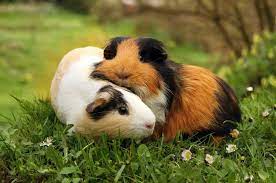 Guinea pigs make good companions for children and adults alike. They are active, social animals and can be great fun to keep. Also known as Cavies, guinea pigs originate from Peru in South America. There are three main breeds of guinea pigs, and each has a different style coat.
Guinea pigs make good companions for children and adults alike. They are active, social animals and can be great fun to keep. Also known as Cavies, guinea pigs originate from Peru in South America. There are three main breeds of guinea pigs, and each has a different style coat.
The most common breed of guinea pig is the English. It is smooth-coated, with short fur that has a glossy shine. The Abyssinian guinea pig has fluffy fur all over the body, while the Peruvian breed has long hair with a silky feel to it.
Housing
 Traditionally, guinea pigs are kept in a hutch outdoors. This hutch needs to be as large as possible in order to give the guinea pig plenty of room to run around. Make sure you purchase a sturdy hutch and keep it raised at least 25cm off the ground in order to protect the guinea pig from predators and to keep the base of the hutch dry. If you decide to keep your guinea pig indoors, you need to keep it in a cage similar to those used to house hamsters, only much larger. Keep the guinea pig’s cage in a cool room, out of direct sunlight and draughts.
Traditionally, guinea pigs are kept in a hutch outdoors. This hutch needs to be as large as possible in order to give the guinea pig plenty of room to run around. Make sure you purchase a sturdy hutch and keep it raised at least 25cm off the ground in order to protect the guinea pig from predators and to keep the base of the hutch dry. If you decide to keep your guinea pig indoors, you need to keep it in a cage similar to those used to house hamsters, only much larger. Keep the guinea pig’s cage in a cool room, out of direct sunlight and draughts.

Bedding
You will need to purchase wood shavings to put down on the floor of the cage to form an absorbent layer. Hay and straw will also help to keep your guinea pig warm at night. Keep the cage as clean as possible by removing soiled bedding and replacing it when needed. Clean out the hutch or cage completely on a weekly basis.

Feeding
 You should feed your guinea pig food in either pellet form or as muesli. Pellets contain the same nutrients as muesli, but as guinea pigs tend to pick out the bits that they like from muesli, a pellet can be better to ensure they get all the nutrients they need.
You should feed your guinea pig food in either pellet form or as muesli. Pellets contain the same nutrients as muesli, but as guinea pigs tend to pick out the bits that they like from muesli, a pellet can be better to ensure they get all the nutrients they need.
At PAWS we recommend Excel Guinea Pig nuggets. These are good for the digestion and the hardness of the nugget keeps the guinea pig’s teeth worn down. These nuggets also contain vitamin C – an essential supplement to a guinea pig’s diet, since it cannot generate this on its own, and will become ill without it.
You can feed your guinea pig with small quantities of fresh fruit and vegetables such as carrots, broccoli and apples. Remember to have hay readily available for your guinea pig at all times, as this provides it with an essential source of vitamin C and fibre.
Make sure your guinea pig always has access to food and water. Water should be changed daily and can be provided in a gravity-fed bottle.

Handling
Use both hands to gently but firmly grasp your guinea pig around its shoulders. Lift it up and support the bottom with your other hand. Hold your pet close to your body, or sit down and place it on your lap so that it feels secure.

